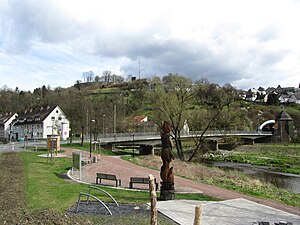Schlossberg (Arnsberg)
| Schlossberg | ||
|---|---|---|
|
Schlossberg from the southwest |
||
| height | 256 m above sea level NN | |
| location | Arnsberg , Hochsauerlandkreis , North Rhine-Westphalia ( Germany ) | |
| Mountains | Arnsberg Forest | |
| Coordinates | 51 ° 24 '5 " N , 8 ° 3' 43" E | |
|
|
||
| particularities | Castle ruins, Schlossberg tunnel | |
The Schlossberg is 256 m above sea level. NN high hill in Arnsberg , North Rhine-Westphalia. The mountain slopes steeply mainly to the west, east and south. Therefore, it was ideally suited for defense. The Counts of Arnsberg built a castle on it. Today this is the ruins of Arnsberg Castle . On the mountain, August Disselhoff composed the folk song “Now ade, you my dear homeland.” The fire department museum of the city of Arnsberg was located on the ascent to the mountain until it was moved to the train station . Every year the ruins festival is celebrated on the castle plateau. Other events also take place there. A few years ago, a vineyard was set up on the slopes at a historic location. Below the mountain, the Ruhr flows both in the east and in the west . The Schlossberg tunnel of the upper Ruhr Valley Railway runs through the mountain . The West German radio operates on the Castle Hill the transmitter Castle Hill .
Ecological importance
The Schlossberg is listed under BK-4514-0012 in the specialist information system of the State Office for Nature, Environment and Consumer Protection in North Rhine-Westphalia . The Schlossberg, with an area of 8.54 hectares, is intended to be designated as a nature reserve . In the NSG delimitation, the mountain summit with ruins and the western and eastern slopes of the mountain are outside the settlement area. Parts of the ruin walls and eastern slope areas are designated as a legally protected biotope according to § 30 BNatSchG.
On the hilltop, in the area of the castle ruins, there is a park with a variety of trees, some of which are old. Some of the walls of the castle ruins, especially in the southeast, south and southwest, have apparently not yet been restored and have well-developed wall joint vegetation and accommodate a mollusc fauna typical of ruins with z. Sometimes rare species such as the endangered door snail. The Roman snail also occurs here. Because of the species-rich mollusc fauna, these walls are a legally protected biotope according to §30 BNatSchG. The Wall diamonds -Occurrence (Asplenium ruta-muraria) on the ruins of walls on the south side is likely to include one of the largest deposits of natural space. The steep rocky mixed forest area on the eastern slope with a large occurrence of mountain elm and also a legally protected biotope according to §30 BNatSchG is outstanding. The western part of the Schlossberg, which is also dominated by hillside forests, has steep slopes in the lower area with former quarries and rock faces. There are sometimes wall joint societies in quarries and rock faces. On the upper western slope there are some extensively managed orchards and above them a small, very natural "historical vineyard". In the woods to the north of the tunnel on the B 7, very dense bushes grow on the very steep, barely accessible west-facing slope, which is made up of bushes and mostly young trees. On the lower slope here too there are former quarries and rocks, the former quarry above a gas station has outcrops with interesting folds. An asphalt path runs parallel to the slope, on which a middle-aged row of linden trees grows. Above there are small retaining walls made of natural stone with fern vegetation, presumably these are abandoned former gardens that are now forested again.


